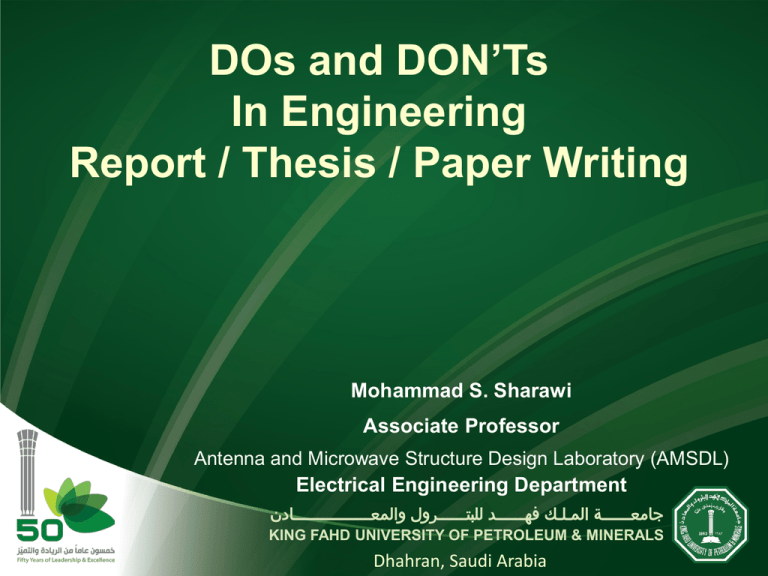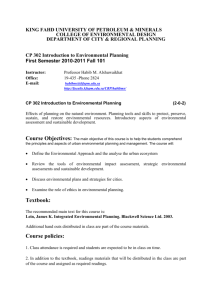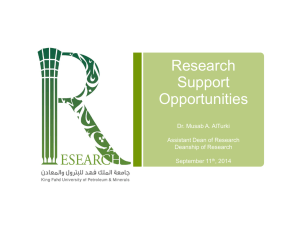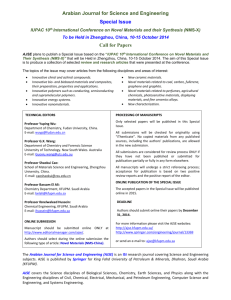DOs and DON`Ts In Engineering Report / Thesis / Paper Writing
advertisement

DOs and DON’Ts In Engineering Report / Thesis / Paper Writing Mohammad S. Sharawi Associate Professor Antenna and Microwave Structure Design Laboratory (AMSDL) Electrical Engineering Department ﺟﺎﻣﻌــــــﺔ اﻟﻤـﻠـﻚ ﻓﻬــــــﺪ ﻟﻠﺒﺘــــــﺮول واﻟﻤﻌــــــــــــــــﺎدن KING FAHD UNIVERSITY OF PETROLEUM & MINERALS Dhahran, Saudi Arabia PRESENTATION SCOPE • Writing Essentials … • Common Mistakes … • DOs … • DON’Ts … • Examples … • Remarks … 2 © 2014, M. Sharawi, KFUPM. PRESENTATION SCOPE • Writing Essentials … • Common Mistakes … • DOs … • DON’Ts … • Examples … • Remarks … 3 © 2014, M. Sharawi, KFUPM. WRITING ESSENTIALS 4 © 2014, M. Sharawi, KFUPM. 5 © 2014, M. Sharawi, KFUPM. 6 © 2014, M. Sharawi, KFUPM. WRITING ESSENTIALS • The general structure of a Thesis/Report – Title Page – Abstract – Introduction and Contribution Summary – Background and Methodology – Literature Review This might differ based on your work and thesis organization! – Design (multiple sections/chapters … as required) – Results and Discussion (multiple sections/chapters … as required) – Conclusions – References 7 © 2014, M. Sharawi, KFUPM. WRITING ESSENTIALS • The general structure of a Paper (Conference/Journal) – Abstract – Introduction, literature review and Contribution Summary – Design (multiple sub-sections … as required) – Results and Discussion (multiple sub-sections… as required) – Conclusions – References 8 © 2014, M. Sharawi, KFUPM. WRITING ESSENTIALS A) Abstract: - Should be written after you finish your report/paper - Should highlight the contribution of your work and its importance - Should be concise, straight to the point, clear, and without equations, figures or diagrams. - Should not exceed one (maximum 2) paragraph(s). 9 © 2014, M. Sharawi, KFUPM. 10 © 2014, M. Sharawi, KFUPM. WRITING ESSENTIALS Example: 11 © 2014, M. Sharawi, KFUPM. WRITING ESSENTIALS B) Introduction: - Should pave the way to the reader towards your work - Mention the importance of the general area - show some diagrams related to the topic and its importance if in a report (not in a paper) - Go over some features of the technology in general - can have multiple sub-sections 12 © 2014, M. Sharawi, KFUPM. WRITING ESSENTIALS Example: Need for Wireless Devices and future Expectations. SDR and CR and their features MIMO … RF Direction Finding …. 13 WRITING ESSENTIALS C) Literature Review: - Very critical to cite references - Figures you copy from references should be cited - Create a literature review TREE showing the classifications you made and highlight the area where your work fits 14 © 2014, M. Sharawi, KFUPM. WRITING ESSENTIALS Example: 15 © 2014, M. Sharawi, KFUPM. 16 © 2014, M. Sharawi, KFUPM. WRITING ESSENTIALS D) Results and Discussion: - Figure Captions are at the BOTTOM - Table Captions are at the TOP - All figures, and Tables should be described in the TEXT before they are first mentioned. - Always describe what the figure is showing, its meaning and explanation. 17 © 2014, M. Sharawi, KFUPM. WRITING ESSENTIALS Example: 18 © 2014, M. Sharawi, KFUPM. WRITING ESSENTIALS E) Conclusions: - Summaries the contributions and findings of your work. - Not exactly the same as Abstract, but contains similar major information - Should be several paragraphs long in a Thesis, and one paragraph in a Paper. 19 © 2014, M. Sharawi, KFUPM. WRITING ESSENTIALS Example: 20 © 2014, M. Sharawi, KFUPM. WRITING ESSENTIALS F) References: - Always follow IEEE Style is ALL your work, papers, reports …etc. Example: [12] R. Hussain, M. U. Khan and M. S. Sharawi, “Test Paper,” IEEE Transactions on Education, Vol. 1, No. 2, pp. 34-39, 2010. 21 © 2014, M. Sharawi, KFUPM. PRESENTATION SCOPE • Writing Essentials … • Common Mistakes … • DOs … • DON’Ts … • Examples … • Remarks … 22 © 2014, M. Sharawi, KFUPM. COMMON MISTAKES • The way you layout the report/paper • The way you present captions to figures and tables • The way you describe figures and tables • The way you write Abstracts and conclusions Pretty much …. Most of what you write has issues at the beginning! 23 PRESENTATION SCOPE • Writing Essentials … • Common Mistakes … • DOs … • DON’Ts … • Examples … • Remarks … 24 © 2014, M. Sharawi, KFUPM. DO … • Always Check your Figure/Table number order and match it with written text • Always describe EACH Figure/Table you have in Text in details • Always cite any image you use from OTHERS • NEVER copy/paste from other works!! We can catch you … this is PLAGIARISM!! Harsh Punishment!! 25 © 2014, M. Sharawi, KFUPM. DO … • When we provide one comment on a section to change, FOLLOW THE SAME WITH ALL OTHER SECTIONS • In your presentation, place references related to the current slide at the end of the same slide with smaller READABLE font • References in sequence should be grouped, i.e. [1], [2], [3], [4], should be [1] - [4]. • Equations are in ( ) (i.e. Eq. (2.3)), while references are in [ ]. 26 © 2014, M. Sharawi, KFUPM. DO … • Always define all parameters in Equations, right after the equation • Always define abbreviations the first time you use them, and from that point onwards, use the abbreviated expression 27 28 © 2014, M. Sharawi, KFUPM. PRESENTATION SCOPE • Writing Essentials … • Common Mistakes … • DOs … • DON’Ts … • Examples … • Remarks … 29 © 2014, M. Sharawi, KFUPM. DON’T … • NEVER user different font sizes and types for the text in different sections … All should be same. • NEVER ALTER A TEMPLATE (especially for a conference or a journal) • NEVER IGNORE a CORRECTION given to you • NEVER Start a section with a subsection number, always write a short paragraph describing what will be in the new section 30 © 2014, M. Sharawi, KFUPM. DON’T … • Never place Figures/Tables next to text, always figures are placed in the middle between paragraphs • Never submit your paper/thesis before reading it TWICE at least … you need to identify simple issues before submitting it to your professor! i.e. missing bookmarks, Figures, etc … 31 © 2014, M. Sharawi, KFUPM. COMMON MARKS YOU WILL SEE ON YOUR CORRECTED REPORTS/PAPERS • // New Paragraph • ^ Add text written in this position Answer this question HERE (in the box), or • there is a REMARK in the box for you to take action • * Add text from this location to another location with the same mark (move text) • [ . ] Add a reference 32 © 2014, M. Sharawi, KFUPM. PRESENTATION SCOPE • Writing Essentials … • Common Mistakes … • DOs … • DON’Ts … • Examples … • Remarks … 33 © 2014, M. Sharawi, KFUPM. EXAMPLES 1) COMMENTS on a newly submitted Proposal. 34 COMMENTS on a newly submitted Proposal. 35 © 2014, M. Sharawi, KFUPM. EXAMPLES 2) Final Version of an ACCEPTED Journal paper 36 Final Version of an ACCEPTED Journal paper 37 PRESENTATION SCOPE • Writing Essentials … • Common Mistakes … • DOs … • DON’Ts … • Examples … • Remarks … 38 © 2014, M. Sharawi, KFUPM. REMARKS • Becoming a good writer needs practice and time Be patient and focus • Becoming a good writer comes with being a good reader (a good reader will catch the way article, reports, papers and books are written, and then he can imitate the style) • It is natural and OK to have 5 corrected versions of your first paper/report • It is expected that the mistakes you make the first time to be avoided in ALL FUTURE WRITUPS! 39 THE END!!! msharawi@kfupm.edu.sa 40 © 2014, M. Sharawi, KFUPM.



